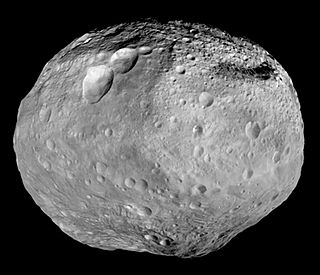
A protoplanet is a large planetary embryo that originated within a protoplanetary disk and has undergone internal melting to produce a differentiated interior. Protoplanets are thought to form out of kilometer-sized planetesimals that gravitationally perturb each other's orbits and collide, gradually coalescing into the dominant planets.

HD 209458 b is an exoplanet that orbits the solar analog HD 209458 in the constellation Pegasus, some 157 light-years from the Solar System. The radius of the planet's orbit is 0.047 AU, or one-eighth the radius of Mercury's orbit. This small radius results in a year that is 3.5 Earth-days long and an estimated surface temperature of about 1,000 °C. Its mass is 220 times that of Earth and its volume is some 2.5 times greater than that of Jupiter. The high mass and volume of HD 209458 b indicate that it is a gas giant.

HD 149026 b, formally named Smertrios, is an extrasolar planet and hot Jupiter approximately 250 light-years from the Sun in the constellation of Hercules.

The NASA Distinguished Public Service Medal is an award similar to the NASA Distinguished Service Medal, but awarded to non-government personnel. This is the highest honor NASA awards to anyone who was not a government employee when the service was performed.

HD 164922 is a seventh magnitude G-type main sequence star in the constellation of Hercules. To view it, binoculars or a telescope are necessary, as it is too faint to be visible to the naked eye. It is 71.7 light-years distant from the Earth. It will soon evolve away from the main-sequence and expand to become a red giant.

HD 189733 b is an exoplanet in the constellation of Vulpecula approximately 64.5 light-years away from the Solar System. Astronomers in France discovered the planet orbiting the star HD 189733 on October 5, 2005, by observing its transit across the star's face. With a mass 11.2% higher than that of Jupiter and a radius 11.4% greater, HD 189733 b orbits its host star once every 2.2 days at an orbital speed of 152.0 kilometers per second, making it a hot Jupiter with poor prospects for extraterrestrial life.

HD 3346, also known as V428 Andromedae, is a binary star system in the northern constellation of Andromeda. It is a dim star but visible to the naked eye under suitable viewing conditions, having an apparent visual magnitude of 5.14. The distance to HD 3346 can be determined from its annual parallax shift of 4.72 mas. This yields a range of about 690 light-years. At that distance the brightness of the system is diminished by an extinction of 0.16 magnitude due to interstellar dust. It is moving closer to the Earth with a heliocentric radial velocity of −33 km/s.
HD 222582 b is an extrasolar planet that is 8.37 times the mass of Jupiter orbiting the star HD 222582. The orbital period is 572 days and orbits at a semimajor axis of 1.35 AU in one of the most eccentric orbits of the known planets.

Endeavour is an impact crater located in the Meridiani Planum extraterrestrial plain within the Margaritifer Sinus quadrangle (MC-19) region of the planet Mars. Endeavour is about 22 kilometers (14 mi) in diameter. Using Mars Reconnaissance Orbiter data, phyllosilicate-bearing outcrops have been detected along its rim. These minerals may have formed under wet conditions in a low-acidic environment during the early history of Mars. There are raised rim segments to the north, east, and southwest. The rim has become worn, rounded and degraded, with infilling of plains material in a manner similar to the Victoria crater.
HD 156668 is a star in the northern constellation of Hercules constellation. With an apparent visual magnitude of 8.4 it is too faint to be viewed with the naked eye, but it can be seen with even a small telescope. The distance to this object has been determined directly using the parallax technique, yielding a value of about 80 light-years.

An exoplanet is a planet located outside the Solar System. The first evidence of an exoplanet was noted as early as 1917, but was not recognized as such until 2016; no planet discovery has yet come from that evidence. What turned out to be the first detection of an exoplanet was published among a list of possible candidates in 1988, though not confirmed until 2003. The first confirmed detection came in 1992, with the discovery of terrestrial-mass planets orbiting the pulsar PSR B1257+12. The first confirmation of an exoplanet orbiting a main-sequence star was made in 1995, when a giant planet was found in a four-day orbit around the nearby star 51 Pegasi. Some exoplanets have been imaged directly by telescopes, but the vast majority have been detected through indirect methods, such as the transit method and the radial-velocity method. As of 24 July 2024, there are 7,026 confirmed exoplanets in 4,949 planetary systems, with 1007 systems having more than one planet. This is a list of the most notable discoveries.








